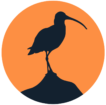What are curlews?
Curlews are large brown birds, all belonging to the Numenius genus. All curlew species have long, curved bills, long legs and mottled brown plumage.
All curlews are considered waders – or shorebirds (the North American terminology, though there is some confusion between waders, shorebirds and shore birds. Wader Quest delve into the difference in this Wader Guru Q&A) – which is the common name for birds in the Charadiiformes order. There are around 200 species of waders. In addition to the curlews, other waders include plovers, oystercatchers, jacanas, and avocets.
How many species of curlew are there?
There are nine extant (living) species of curlew, although this may change if the Slender-billed or the Eskimo Curlew are confirmed as extinct.
Eurasian Curlew (Numenius arquata)

The Eurasian Curlew is the main curlew species that Curlew Action focuses on, as it the iconic bird which inspired Mary Colwell's walk and following book, Curlew Moon.
The Eurasian Curlew is a large brown wading bird with a distinctive long and downcurved bill, which is particularly long in females. It has a broad distribution range across Europe, Asia and Africa. Once a common sight in the UK and Ireland, numbers have dramatically declined as the species faces a range of threats on both its breeding and its wintering habitats.
Although the Curlew is migratory bird, it can be found year-round in the UK. Whilst some Curlews migrate within the UK between the coast in winter and their breeding grounds, others will migrate to Europe to breed.
It shares some of its range with the Eurasian Whimbrel. Some of the key identification features to tell the two species apart are the size (Curlews are larger than Whimbrels), bill size (longer in Curlews) and plumage (including the more notable pale stripe above the eye in Whimbrels, known as the supercilium).
Listen to our podcast episodes on the Eurasian Curlew:
- Geoff Hilton - Saving the Eurasian Curlew
- Curlew in the 21st century
- Irish Curlew Crisis
- Galloway Curlews
- Urban Curlews
Eurasian Whimbrel (Numenius phaeopus)
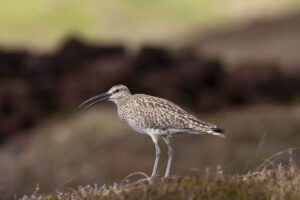
Similar in plumage and shape to the Eurasian Curlew, the Eurasian Whimbrel is not quite as large or sadly, as iconic. It breeds across subarctic Europe and Asia, and migrates to southern Europe and Africa for the winter. In the UK, its breeding range is restricted to northern Scotland.
Long-billed Curlew (Numenius americanus)
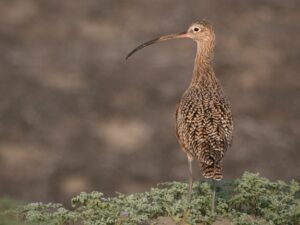
The largest wader in the Americas, the Long-billed Curlew has been called a variety of folk names including Sickle Bird, Old Smoker and Candlestick Bird. It breeds in the grasslands of northwestern US and southwestern Canada, and migrates south in water to the west coast of the US, Mexico, Guatemala and Honduras.
Listen to our podcast episode on the Long-billed Curlew.
Little Curlew (Numenius minutus)
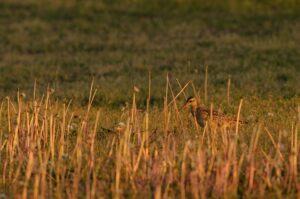
Also known as the Little Whimbrel, the Little Curlew is the smallest of the curlew species. Despite its smaller size, it still undertakes an impressive migration, breeding in north-eastern Siberia and wintering in Australia.
Far Eastern Curlew (Numenius madagascariensis)
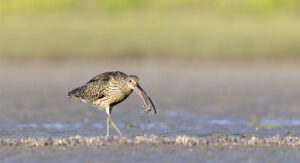
The Far Eastern Curlew is the largest migratory wader in the world, which breeds in the Northeastern Asia including Siberia, the Kamchatka Peninsula in Russia and northern China. In winter, it flies south to Australia, with some individuals also being found in New Zealand, Japan, the Philippines and Indonesia.
In Australia, numbers have declined by 81%, which is thought to be mainly due to habitat destruction in both the Yellow Sea and in Australia.
Listen to our podcast episodes on the Far Eastern Curlew:
Bristle-thighed Curlew (Numenius tahitiensis)

The Bristle-thighed Curlew is a medium-size curlew species, with brown plumage and a cinnamon rump. It nests in just two areas in the remote tundra of western Alaska, and migrates to small islands and atolls in the Central Pacific for winter, including Fiji, French Polynesia and Hawaiian Islands. The minimum distance between the breeding and non-breeding range is about 5,000 km, which it must travel in a non-stop flight.
The English name of ‘Bristle-thighed’ is derived from its thigh feathers, which have elongated bare shafts.
Listen to our podcast episode on the Bristle-thighed Curlew.
Hudsonian Whimbrel (Numenius hudsonicus)
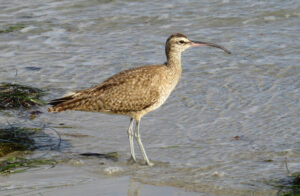
Once thought to be a subspecies of the Eurasian Whimbrel, the Hudsonian Whimbrel was recently elevated to species level. It has a dark rump, rather than the white rump of the Eurasian Whimbrel. It breeds in subarctic North America, and flies to southern North America and to South America for the winter.
Listen to our podcast episode on the Amberican Whimbrel.
Slender-billed Curlew (Numenius tenuirostris)
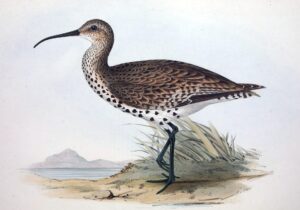
The last verifiable photo of the Slender-billed Curlew was in 1995, photographed by ornithologist Richard Porter in Yemen (interviewed by Mary Colwell, see podcast link below). It is not yet listed as Extinct In The Wild or Extinct by the IUCN Red List, but many conservationists believe it is extinct.
It was a relatively small curlew species, about the same size as a Eurasian Whimbrel. Its only known breeding range was in southwest Siberia in the early 1900s, and it was thought to have migrated westwards and southwards to southern Europe and northwest Africa. It is likely to have also bred in the steppes of Kazakhstan, which was discovered by comparing the soil isotopes to those in the feathers of museum specimens.
Listen to our podcast episodes on the Slender-billed Curlew:
Eskimo Curlew (Numenius borealis)

Also known as the Northern Curlew, the Eskimo Curlew is another Curlew species thought to be extinct (although it is not yet listed as such on the IUCN Red List). The last confirmed sightings were in the 1960s. However, there was also a report of 23 Eskimo Curlews seen on a remote island off the coast of Texas in the early 1980s (see our podcast link below).
Once numbering in its millions, the species bred in Alaska and Canada, and migrated to South America for winter.
Listen to our podcast episode and YouTube discussion on the Eskimo Curlew:
Confusing non-curlew birds
Although they have the word ‘Curlew’ in their name, neither the Curlew Sandpiper (Calidris ferruginea) nor the Stone Curlews (ten species in the Burhinidae family, also known as dikkops or thick-knees) are actually species of curlew.
Are Hudsonian Whimbrels actually a separate species?
For a long time, the Hudsonian Whimbrel was considered to an American subspecies of the Eurasian Whimbrel. However, a 2019 paper on the population genomics of Eurasian Curlew and Whimbrel published in Nature Scientific Reports suggested that it should be elevated to species level. This was accepted in the International Ornithological Congress World Bird List 10.1 and in the British Ornithologists’ Union Records Committee 51st Report.
Which curlews are found in the UK?
Two species of curlew are resident and breeding in the UK, the Eurasian Curlew and the Eurasian Whimbrel.
The Hudsonian Whimbrel is rarely found in the UK, appearing here as a vagrant. The BTO lists that the first UK record was at Fair Isle in 1955, with less than 20 records since.
Are curlews endangered?
Of the nine species of curlew, two are listed as Critically Endangered on the International Union for Conservation of Nature’s (IUCN) Red List of Threatened Species, one as Endangered, two as Near Threatened, and three as Least Concern. The Hudsonian Whimbrel has not yet been assessed by the IUCN Red List (are there plans to?).
The IUCN Red List was established in 1964 as a tool to analyse the health of animal, plant and fungi populations and thus, the biodiversity of the world. A species can be listed in nine categories: Not Evaluated, Data Deficient, Least Concern, Near Threatened, Vulnerable, Endangered, Critically Endangered, Extinct in the Wild and Extinct.
For the two Critically Endangered species – Slender-billed and Eskimo – many conservationists believe they may actually be extinct. The last confirmed sighting of a Slender-billed Curlew was in Morocco in 1995. The last confirmed photograph of an Eskimo Curlew was taken in 1962 and the last confirmed sighting was in 1963, when one was shot in Barbados.
- Eurasian Curlew – Near Threatened (date last assessed: 2017)
- Eurasian Whimbrel – Least Concern (2016)
- Long-billed Curlew – Least Concern (2016)
- Little Curlew – Least Concern (2016)
- Far-Eastern Curlew – Endangered (2016)
- Hudsonian Whimbrel – Not Evaluated
- Slender-billed Curlew – Critically Endangered (2018)
- Eskimo Curlew – Critically Endangered (2020)
- Bristle-thighed Curlew – Near Threatened (2020)
What are the threats to curlews?
Curlews face a wide range of threats, including habitat loss and degradation, disturbance, changes in farming practices, predation, hunting, and climate change.
Which is the largest and smallest species of curlews?
The Far Eastern Curlew is the largest curlew species, with a body length measuring between 53-66cm, a wingspan of 110cm, and a weight between 565-1,150g. The species nearly doubles in weight before its migration.
As the name suggests, the Little Curlew is the smallest species of curlew. It has a body length of between 28-34cm, a wingspan of between 68-71cm, and a weight of between 118-221g.
When is World Curlew Day and World Shorebird Day?
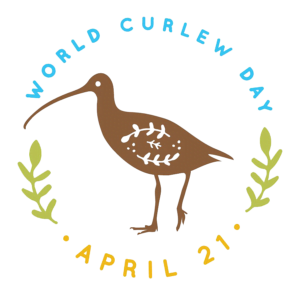
World Curlew Day was created by Mary Colwell in 2017 to raise awareness of Curlews and their declining populations. It is celebrated on 21st April, which is the same day as St Beuno’s feast day and the day that Mary Colwell began her 500-mile walk for Curlews in 2016. St Beuno is the patron saint of Curlews, after a Curlew saved the seventh-century Welsh missionary's book of sermons from the sea.
World Shorebirds Day is celebrated on 6th September and aims to raise public awareness of the world’s shorebird species. It was created by Gyorgy Szimuly, a shorebird conservationist, and encourages people to take part in the Global Shorebird Counts via eBird.
Lead image: Eurasian Curlew. (Photo by RTS Photography)
